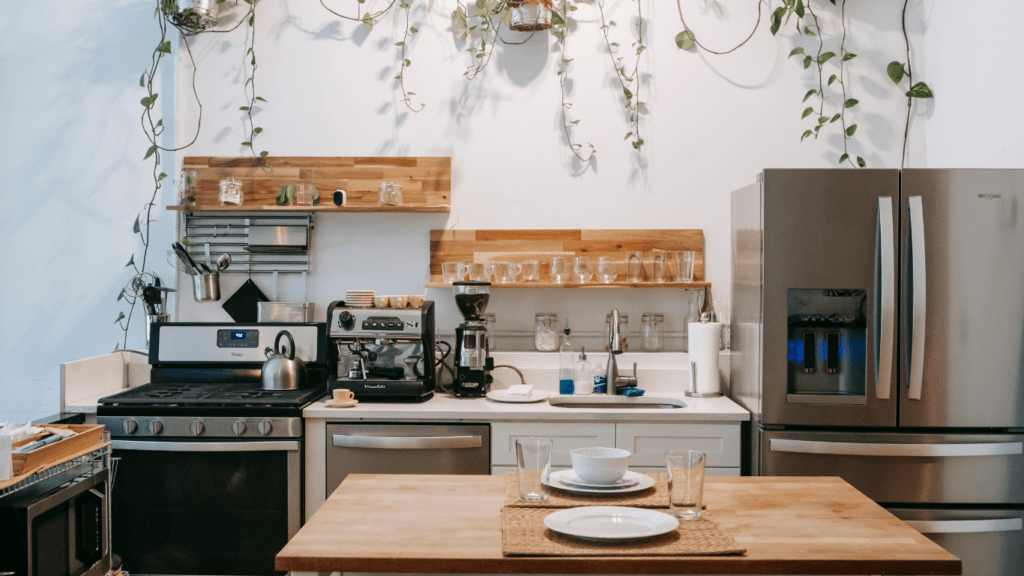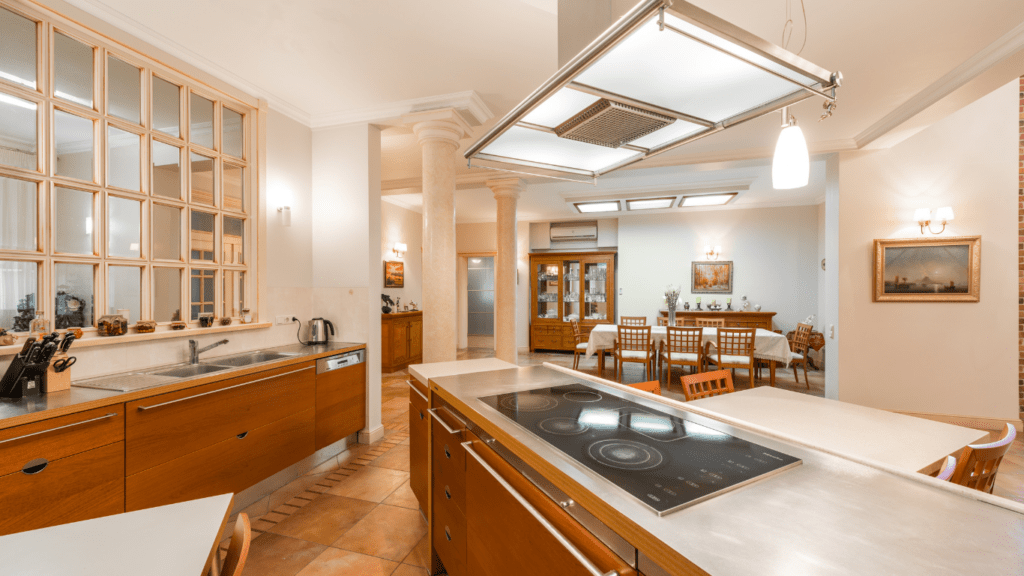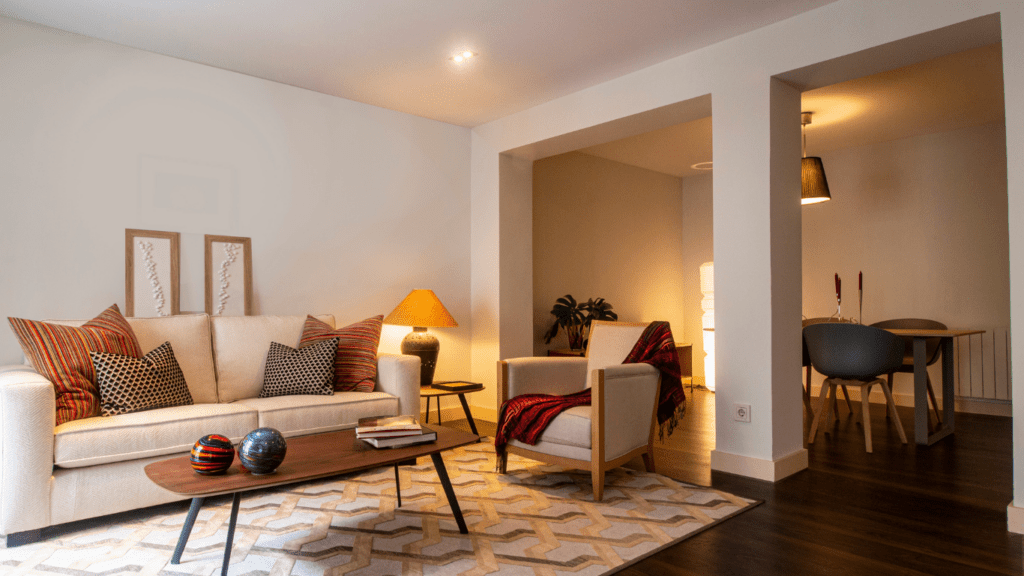Understanding Your Space
Assessing the dimensions of your dining room helps determine the best furniture placement. Measure the length and width of the room to understand its overall size. Note architectural elements like:
- windows
- doors
- built-in features
to avoid obstructing them. Identify the focal point of the space. This could be a structural feature or a decorative element like a fireplace or a large window. Arrange the furniture to enhance this focal point, creating a visually appealing layout.
Consider the flow of movement. Ensure there is ample space for guests to move comfortably around the table. Leave at least 36 inches of clearance between the edge of the table and walls or other furniture.
Account for multipurpose use. If the dining room also functions as a workspace or play area, make sure the furniture arrangement accommodates these activities without cluttering the space. Choose versatile pieces that can be easily repositioned.
Inspect lighting and electrical outlets. Position the table beneath a central light fixture for even illumination. Place sideboards or buffets near outlets if they will support appliances or lamps. This maximizes both function and aesthetics.
Factoring in these elements, you can create an inviting and efficient dining room tailored to your entertaining needs.
Essential Furniture Pieces
To create an inviting and functional dining room, having the right furniture is crucial. I’ll discuss essential pieces and how to place them effectively.
Dining Table
The dining table is the centerpiece of any dining room. Choose a table that fits comfortably in your space, ideally leaving at least 36 inches around it for movement. Round tables work well in smaller rooms while rectangular ones suit larger areas. When selecting a table, consider not just size, but also the style and material to match your decor.
Seating Options
Comfortable seating is essential for enjoyable dining. Use chairs that provide enough support and are proportionate to your table’s height. For larger gatherings, consider benches or additional chairs that can be easily stored when not in use. Mixing different seating styles can add visual interest and accommodate various preferences.
Storage Solutions
Storage keeps the dining room organized and clutter-free. Use sideboards or buffets to store dishes, utensils, and table linens. A hutch can display decorative items while providing additional storage. If space is limited, consider wall-mounted shelves or corner cabinets to optimize every inch of your dining area.
Optimal Furniture Placement Tips
Thoughtful placement of dining room furniture can transform the space into an inviting and functional area for entertaining. Here are some actionable tips to achieve optimal results.
Creating a Focal Point
Position the dining table as the room’s centerpiece. Center the table under a chandelier or pendant light to draw the eye. Use a statement piece like artwork or a decorative mirror on the main wall to enhance the focal point. Ensure the table’s proportions suit the room’s dimensions for visual harmony.
Ensuring Proper Flow
Ensure at least 36 inches of clearance around the table for easy movement. Place chairs with enough space to slide in and out comfortably. Avoid obstructing doorways and pathways to maintain a natural traffic flow. Consider arranging furniture to guide guests towards seating, encouraging natural circulation.
Balancing Function and Aesthetics
Mix seating styles for visual interest while maintaining comfort. Use benches or armless chairs for additional seating without crowding the space. Select functional pieces like sideboards and buffets for extra storage without sacrificing aesthetics. Incorporate multi-purpose furniture, such as a dining table with expandable leaves, to adapt to different events.
Personalizing Your Dining Room

Personalizing your dining room elevates the entire space and reflects your individual style. Focus on blending aesthetics and functionality for a welcoming atmosphere.
Incorporating Decorative Elements
- Decorative elements breathe life into a dining room, making it uniquely yours.
- I recommend using wall art, mirrors, and plants as focal points.
- Wall art adds visual interest and reflects personal taste.
- Mirrors expand the space, enhancing lighting and creating the illusion of a larger room.
- Indoor plants bring freshness and can help improve air quality.
- Lighting fixtures also play a crucial role, whether it’s a statement chandelier or pendant lights, adding elegance and warmth.
Adjusting for Specific Occasions
Flexibility in furniture arrangement allows for easy adaptation to various events. For casual gatherings, consider a more relaxed setup with mixed seating options. For formal dinners, arrange chairs uniformly and ensure enough space for setting the table. Incorporate folding tables or extendable ones for larger groups, and use multifunctional furniture like sideboards for serving dishes. Decor, such as table runners and centerpieces, can be swapped based on the occasion to keep the dining room fresh and inviting.
Common Mistakes to Avoid
Overcrowding the Space
Many make the mistake of cramming too much furniture into the dining room. A crowded room feels cluttered and restrictive. Aim to leave at least 36 inches of clearance around the dining table for easy movement. Avoid oversized cabinets and sideboards unless space allows.
Ignoring Traffic Flow
Poor traffic flow can disrupt the dining experience. Place furniture in a way that facilitates natural movement around the room. Ensure there’s a clear path from the kitchen to the dining area. Move chairs slightly away from walls to allow easy access.
Mismatched Furniture Size
Furniture that doesn’t fit the room’s scale can look awkward. Choose a dining table that suits the room’s dimensions. A large table in a small room can overwhelm the space, while a tiny table in a large room feels out of place. Match table size with room size to maintain balance.
Neglecting Lighting
Inadequate lighting affects ambiance and functionality. Place the dining table under a central light fixture like a chandelier or pendant light. Supplement with wall sconces or floor lamps if needed. Adjust lighting to suit different occasions, whether it’s an intimate dinner or a lively gathering.
Skimping on Comfort
Uncomfortable seating can ruin a dining experience. Choose chairs with appropriate padding or ergonomic designs. Avoid chairs that are too hard or either too high or too low for the table height. Comfort is key for enjoyable dining and prolonged conversations.
Forgetting Multi-Purpose Needs
Failing to account for multifunctional use limits the room’s potential. Consider extendable tables and versatile furniture that can adapt to different events. Ensure there’s enough space for storage within easy reach, like sideboards or shelves, to accommodate various needs.
Ignoring Style Cohesion
A lack of style cohesion can make the room look chaotic. Aim for a balanced mix of styles and materials that complement each other. Match the dining table with chairs that enhance the room’s overall decor. Add decorative elements like artwork and plants for consistency.
Inadequate Storage Solutions
Insufficient storage leads to clutter. Incorporate storage solutions like sideboards, buffets, and shelves. Store tableware, linens, and decorative items neatly to keep the dining room organized. Ensuring ample storage simplifies entertaining and enhances room functionality.
Every element matters when arranging dining room furniture. By avoiding these common mistakes, you can create a comfortable, welcoming space perfect for entertaining any occasion.



 Betsylie Sheetsin – Home Renovation Expert
Betsylie Sheetsin serves as the Home Renovation Expert at Castle Shelf House, specializing in giving practical advice for both small and large-scale home improvements. With years of experience in construction and renovation, Betsylie understands the importance of blending durability with design. Her insights into home renovation projects, along with expert advice on the latest materials and techniques, empower homeowners to tackle even the most ambitious projects confidently.
Betsylie Sheetsin – Home Renovation Expert
Betsylie Sheetsin serves as the Home Renovation Expert at Castle Shelf House, specializing in giving practical advice for both small and large-scale home improvements. With years of experience in construction and renovation, Betsylie understands the importance of blending durability with design. Her insights into home renovation projects, along with expert advice on the latest materials and techniques, empower homeowners to tackle even the most ambitious projects confidently.
